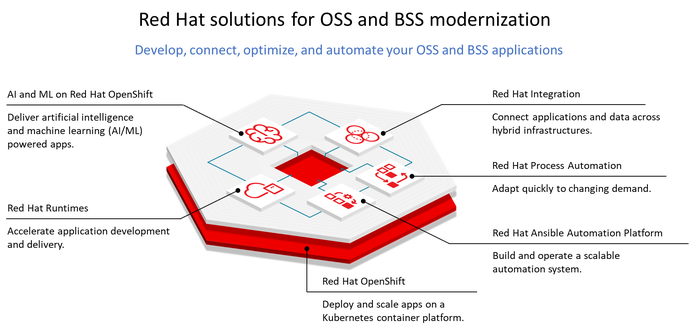OSS/BSS Modernization: Amdocs MS360 Cloud Native Development Platform
October 28, 2020

By Dr. Mark H Mortensen, Principal Analyst, ACG Research
This article is sponsored by Red Hat and Intel
Operations support systems (OSS) and business support systems (BSS) are being rewritten or refactored to cloud-native, microservices-based applications capable of running on hybrid cloud and multicloud computing and storage infrastructure. As a part of its transition, Amdocs created Microservices360 (MS360), an end-to-end carrier-grade accelerated microservices development platform for its own new generation of products, called CES 20. CSPs can use it for co-development with Amdocs or their own development purposes, as it provides a full SDK for cloud-native code development and deployment. MS360 leverages the Red Hat OpenShift container platform deployable solution architecture to optimally run on carrier-grade Intel computing and storage technology.
Introduction
This article provides a summary of the webinar, jointly sponsored by Red Hat and Intel, titled “Realize your OSS/BSS modernization vision today: Accelerating microservices development.” We describe the current movement of OSS/BSS to a hybrid cloud infrastructure and describe how one leading vendor, Amdocs, maximized use of the Red Hat solution for OSS and BSS modernization. This solution for OSS and BSS, as well as containerized network functions (CNFs), runs optimally on CSP-tuned computing and storage technology by Intel.
OSS/BSS in the Clouds
Cloud-native software technology was created by the web-scale players using modern Service Oriented Architecture (SOA), DevOps development methodology, and Continuous Integration/Continuous Deployment (CI/CD) implementation techniques. These techniques were embodied in tool sets released to the open source community and represent the current state of the art in software. Vendors and CSPs have been executing pilot programs with these technologies and have proved them out for telecommunications use cases. They are now moving OSS and BSS systems to cloud native architecture through a combination of re-coding and refactoring.
My Take: Now that it has been proven, cloud -native software is being rapidly deployed in the telecoms industry as CSPs become digital service providers. ACG Research estimates that, today, about 30% of newly deployed OSS and BSS are cloud based. By 2025, that figure will rise to 90%, and most CSPs will have plans for the eventual phase-out of non-cloud-native OSS/BSS.
Amdocs MS360: A Comprehensive Development Platform
As Amdocs prepared to move its products to cloud technology, creating the CES 20 cloud-native OSS/BSS suite, it decided to create an accelerated development platform for containerized microservices for its own use leveraging best practices and incorporating open source tools. Amdocs MS360 was the result. It provides an environment with intrinsic security for developers to use from design to deployment of their containerized or virtualized microservices on hybrid cloud infrastructures.

Figure 1. Amdocs MS360 Development Platform (Source: Amdocs, 2020)
My Take: The Amdocs MS360 accelerated development platform provides a robust end to end solution for both Amdocs and CSPs to develop and deploy, at scale, cloud-native software on any cloud or clouds. Of particular importance is the potential for co-development between Amdocs and a CSP, both using the same environment. In co-development, Amdocs can do the feature-rich, complex microservices and expose their interfaces for the CSP’s developers to add functionality, especially user interfaces. Co-development has the potential to change the industry profoundly, providing unprecedented levels of microservices development acceleration in a cost effective way.
Red Hat OSS/BSS Modernization Solutions
For service providers, OSS and BSS are fundamental and crucial to innovate and compete in quickly changing markets. It’s no longer only about billing and operating three or four core services. Now operators are competing in a platform-based economy where innovation is created through partner ecosystems. As digital service providers seek competitive advantage, they need an open and consistent OSS/BSS foundation to build differentiated services with speed, open to an ecosystem that maximizes choice. Red Hat helps service providers and independent software vendors (ISVs) build and run cloud native OSS/BSS solutions on premise and on any cloud with higher efficiency and flexibility.
My Take: Red Hat OpenShift represents a major advance in hybrid cloud/multi-cloud software development and deployment. The other components of the Red Hat OSS and BSS modernization solution are proven, especially Red Hat Integration and Red Hat Automation products, including the Red Hat Ansible Automation Platform. Red Hat is a major player in the move of OSS, BSS, and NFV software to the cloud.

Figure 2. Red Hat OSS/BSS Modernization Solutions (Source: Red Hat, 2020)
Intel
While creating cloud native solutions can be a challenging task, Intel has a history of rising to support similar industry transitions and has already invested in 5G cloudification and network transformation efforts in partnership with Red Hat. Intel was the founder and lead contributor to the Data Plane Development Kit, which just experienced it’s 10-year publishing anniversary, making NFV adoption by Communication Service Providers (CoSPs) possible. Most recently, Red Hat and Intel released a new Reference Implementation, optimized for Cloud-Native Hybrid/Multi-cloud and built using Red Hat OpenShift Container Platform. It is designed to let CSPs and the industry eco-system quickly turn innovations into deployed VNFs/CNFs and transform OSS/BSS systems. This investment in thoroughly verified reference configurations provides a scalable, cost-efficient foundation to achieve deterministic performance for most demanding use cases as well as to lower design and integration risks.
My Take: Intel has been putting significant effort into working with its NFV technology partners for several years, including Red Hat. The Intel platforms represent a strong optimized hardware base for high-performance telco cloud deployments.
Conclusion
The movement of CSPs’ OSS and BSS systems to the cloud and cloud-native technology is underway, helped strongly by companies such as Red Hat and Intel. Amdocs, a leading vendor, created its Microservices360 solution for its CES 20 BSS offerings, making maximum use of the Red Hat and Intel solutions for BSS and OSS modernization. CSPs can use this end-to-end carrier-grade accelerated microservices development environment for co-development and their own development purposes. The time is now for digital service providers to transition to cloud native OSS and BSS solutions to stay competitive, innovate and meet increasing customer expectations.
Read more about:
Vendor SpotlightsYou May Also Like






.png?width=300&auto=webp&quality=80&disable=upscale)


_1.jpg?width=300&auto=webp&quality=80&disable=upscale)


.png?width=800&auto=webp&quality=80&disable=upscale)